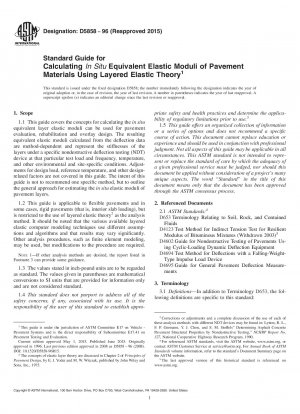ASTM D5858-96(2015)
Standard Guide for Calculating In Situ Equivalent Elastic Moduli of Pavement Materials Using Layered Elastic Theory
- Standard No.
- ASTM D5858-96(2015)
- Release Date
- 1996
- Published By
- American Society for Testing and Materials (ASTM)
- Status
- Replace By
- ASTM D5858-96(2020)
- Latest
- ASTM D5858-96(2020)
- Scope
5.1 This guide is intended to present the elements of an approach for estimating layer moduli from deflection measurements that may then be used for pavement evaluation or overlay design. To characterize the materials in the layers of a pavement structure, one fundamental input parameter measured in the laboratory and used by some overlay design procedures is the resilient modulus. Deflection analysis provides a technique that may be used to estimate the in situ equivalent layer elastic moduli of a pavement structure as opposed to measuring the resilient moduli in the laboratory of small and sometimes disturbed samples. For many overlay design procedures that are based on layered elastic theory, the resilient modulus is approximated by this equivalent layer elastic modulus, because the equivalent modulus is determined as an average value for the total layer at the in situ stress conditions of an actual pavement.
5.2 It should be emphasized that layer moduli calculated with this procedure are for a specific loading condition and for the environmental conditions at the time of testing. For these moduli to be used in pavement evaluations and overlay design, adjustments to a reference temperature, season, and design load may be required. These adjustments are not a part of this guide.
5.3 The underlying assumption used in the solution is that a representative set of layer moduli exists for the particular loading condition (magnitude and area) and temperature condition, such that the theoretical or calculated deflection basin (using quasi-static layered elastic theory and the assumed static load characteristics of the NDT device) closely approximates the measured deflection basin. In reality, depending on the tolerance allowed in the procedure and the relative number of layers compared to the number of deflection sensors, several combinations of moduli may cause the two basins to “match” (or be within tolerance) reasonably well. A certain degree of engineering judgement is necessary to evaluate these alternative solutions and select the most applicable combination or eliminate unreasonable solutions, or both.
5.4 There have been several studies that compared the results of various types of equipment and analysis methods; unfortunately, considerable variability has been noted. At this time, no precision estimate has been obtained from a statistically-designed series of tests with different “known” materials and layer thicknesses. The backcalculated results do vary significantly with the various assumptions used in analysis to emulate the actual condition as well as with the techniques used to produce and measure the deflections. Since the guide deals with a computerized analytical method, the repeatability is excellent if the input data and parameters remain the same. The bias of the procedure can not be established at this time. The identity of the “true” in situ modulus, based on resilient modulus testing or some other field or laboratory test, needs to be standardized before the bias of the method can be established.
1.1 This guide covers the concepts for calculating the in situ......
ASTM D5858-96(2015) Referenced Document
- ASTM D4123 Standard Test Method for Indirect Tension Test for Resilient Modulus of Bituminous Mixtures
- ASTM D4602 Standard Guide for Nondestructive Testing of Pavements Using Cyclic-Loading Dynamic Deflection Equipment
- ASTM D4694 Standard Test Method for Deflections with a Falling-Weight-Type Impulse Load Device
- ASTM D4695 Standard Guide for General Pavement Deflection Measurements
- ASTM D653 Standard Terminology Relating to Soil, Rock, and Contained Fluids*, 1997-04-20 Update
ASTM D5858-96(2015) history
- 2020 ASTM D5858-96(2020) Standard Guide for Calculating
In Situ Equivalent Elastic Moduli of Pavement Materials Using Layered Elastic Theory - 1996 ASTM D5858-96(2015) Standard Guide for Calculating
In Situ Equivalent Elastic Moduli of Pavement Materials Using Layered Elastic Theory - 1996 ASTM D5858-96(2008) Standard Guide for Calculating In Situ Equivalent Elastic Moduli of Pavement Materials Using Layered Elastic Theory
- 1996 ASTM D5858-96(2003) Standard Guide for Calculating
In Situ Equivalent Elastic Moduli of Pavement Materials Using Layered Elastic Theory - 1996 ASTM D5858-96e1 Standard Guide for Calculating In Situ Equivalent Elastic Moduli of Pavement Materials Using Layered Elastic Theory

Copyright ©2024 All Rights Reserved